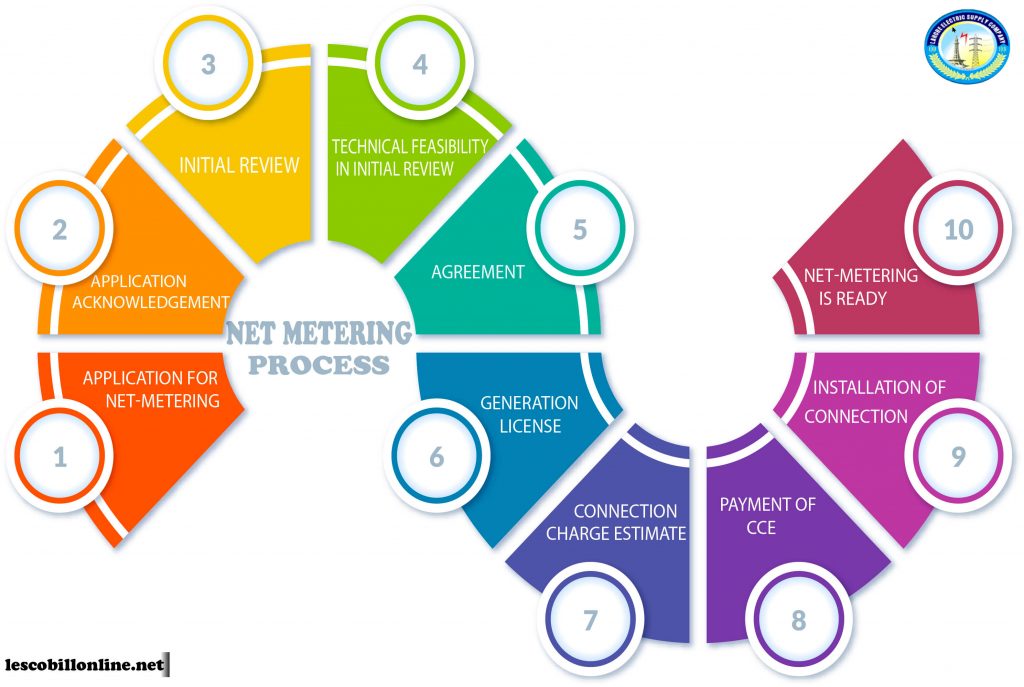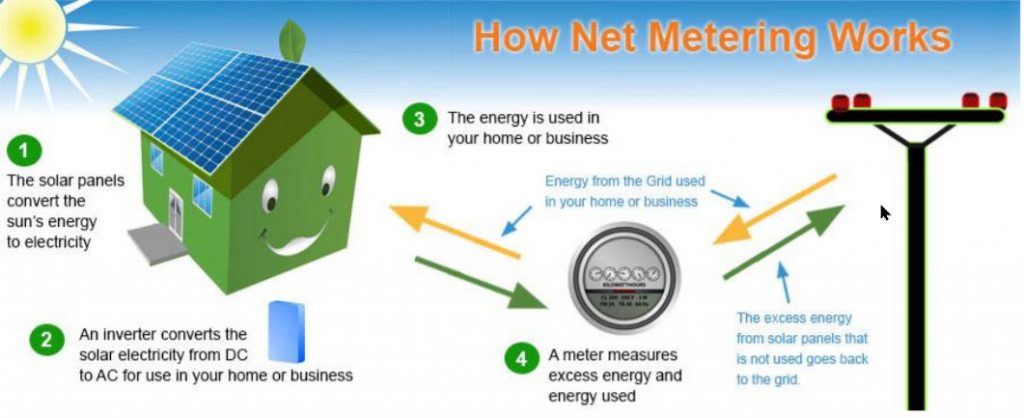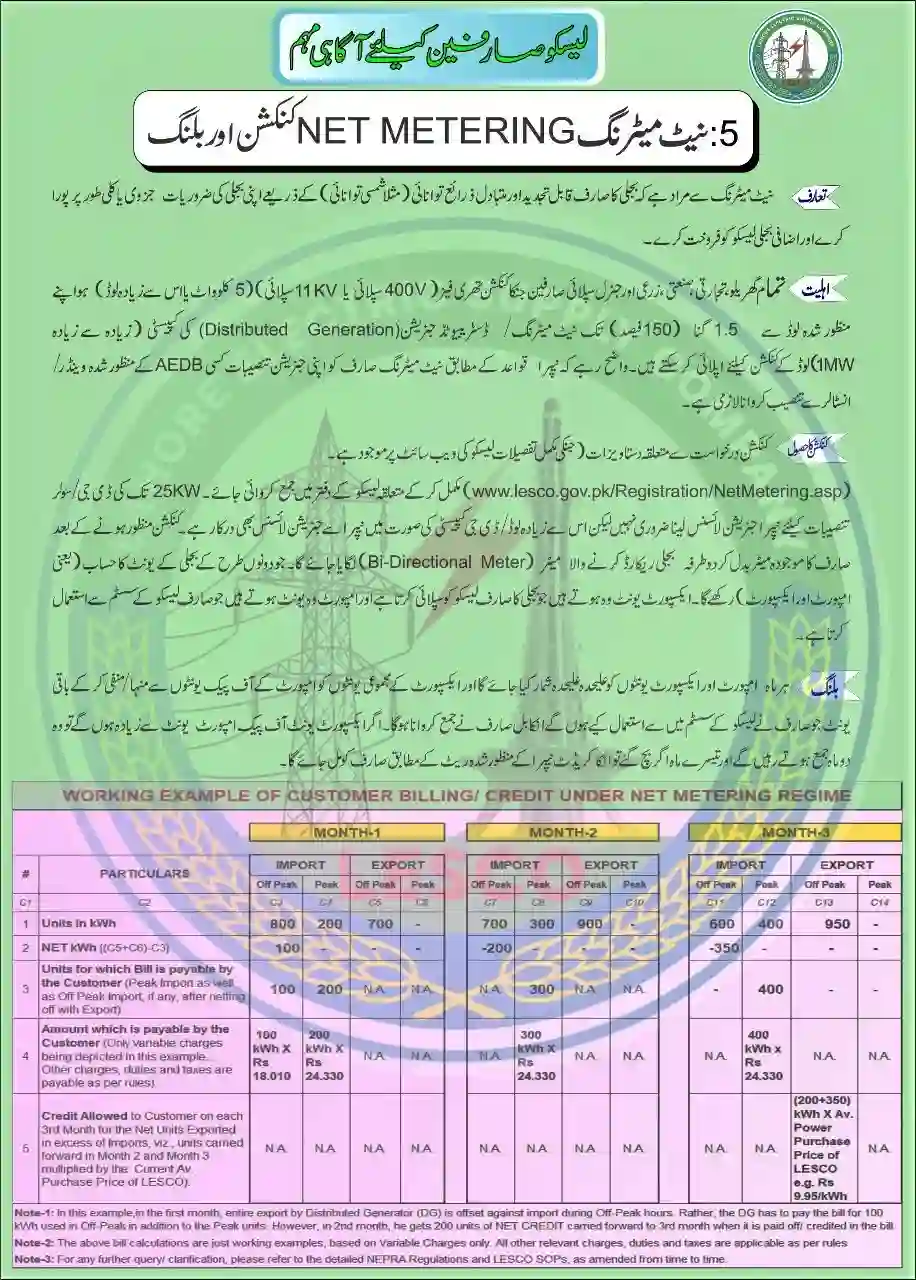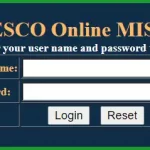HAVE you ever heard that you can generate and sell electricity to your respective power generation company every month through net metering?
YES, YOU CAN!
If you have a green meter installed on your premises like a Shop, Factory, home or any open space, etc. along with a wind or solar system then you can supply the additional or excess energy (Renewable Energy) to the national grid.
As a result, you will pay a reduced electricity bill or get paid for the exported electricity.
For the last 3 to 4 decades, Pakistan has been facing an energy crisis and our energy shortfall has increased by more than 4000MW.
The curve of the demand and supply gap is widening, and its consequences are excessive load shedding and power blackouts.
For more details, you can contact LESCO Customer Support.
How to Apply for Net Metering
To get you a crystal-clear guide to apply for net-metering, here is the list of all the steps involved in the application process and to get a generation license from the DISCOs.

- Application for Net-Metering
- Application Acceptance
- Initial Review by Technical Inspection Team
- Technical Feasibility by DISCO Authorities
- Agreement signed after Application Approval
- Electricity Generation License Issuance
- Connection Charges Estimation
- Payment of Connection Charge Estimate
- Installation of Interconnection Facility

Requirements for Net Metering
Now the question comes to our mind, What are the exact technical requirements of NEPRA that we need to fulfill to be eligible for net metering? So we have compiled a list of those technicalities so you have a complete list.
1. Initial Requirements
When you apply for net metering, your facility must fulfill the NEPRA conditions. And here comes the first one:
NOC by Electrical Inspector: You need to send a written request for a formal visit of a licensed electrical inspection team. They will examine insulation tests, wiring size and sustainability and quality of the whole wiring. If you get rejected, then you can apply again after clearing out the rejection reasons.
Single Line Diagram: For the whole net metering facility
Technical Standards: According to NEPRA rules, your inverters shall comply with UL 1741 standard, IEEE 1547 2003, IEC 61215 or EN or other international standards.
Load Flow Study: If you are capable of producing energy of more than 500kW, then it is mandatory to provide a Load Flow Study on PSSE Software. For customers who are not eligible for production of 500kW, then net metering can be carried out with FDRANA. Additionally, for a 10kW facility, it’s not compulsory.
2. Mandatory Safety Requirements
Before you submit your application for net metering, DISCO will send a team to the feasibility of safety standards.
A: Your inverters have an Anti-Islanding feature
B: The interconnection disconnect switch should comply with IEC and IEEE standards
3. Safety Recommendations by NEPRA
Other than mandatory safety requirements, NEPRA recommends considering some safety recommendations which are as below:
A: Earthing Protection
B: Lighting and Voltage Spikes Protection
C: Good quality circuit breakers to prevent fire
How to Ready Net Metering Bill
LESCO net metering bill is very easy to understand if you know some terms of LESCO net metering tariff and types of units. Let me explain it here briefly.
Peak Hours
During these specified intervals, energy consumption escalates beyond the norm. Typically, the peak periods span from 6 PM to 10 PM during the summer months. Throughout these hours, the cost per unit surges above the usual rate.
Off-Peak Hours
The remaining 20 hours are referred to as off-peak periods, characterized by typically lower energy consumption. During these hours, the unit price is reduced compared to peak hours.
For an in-depth understanding of peak and off-peak hours, you can visit our page at lescobillonline.net
The tariffs differ between these periods, with off-peak hours priced at Rs 14 per unit, while peak hours command a rate of Rs 24.33 per unit.
Import Units
These are the units we draw from the national grid when our system falls short of generating enough power to meet our needs. Typically, during nighttime and peak hours, our system’s output is reduced due to the absence of sunlight, prompting us to rely on backup power stored in batteries.
Once our batteries are depleted, the system automatically pulls power from the national grid to meet the demand, causing the meter to advance. These units are considered negative for us and are not counted among the exported units.
Export Units
During daylight hours, when our system operates at full capacity, it generates more electricity than we consume. These surplus units are fed into the national grid and are termed export units.
This typically occurs during the day when the system’s production exceeds our needs, allowing the extra power to be supplied to the grid.
At this time, the meter runs in reverse, reflecting a negative reading. These units are considered positive for us, as we receive payment for them from our DISCO.
Each month, a green or net meter in your net metering bill shows four specific readings, which can be easily identified by their unique numbers: 6, 7, 8, and 9.
- Number 6 indicates the units imported during peak hours.
- Number 7 reflects the units exported during peak hours, typically zero, as there’s no sunlight at night.
- Number 8 shows the units imported during off-peak hours.
- Number 9 represents the units exported during off-peak hours, with most electricity being exported during these times.
DISCOs sell electricity at higher rates and buy it at lower rates, so your net bill is calculated based on these net unit prices.
Net-Metering Bill Calculation Method
There are two types of Net-Metering Bill calculation i.e. Billing for Peak Hours and Bill for Off-Peak Hours.
1. Net-Metering Bill for Peak Hours
LESCO Net Metering in Pakistan
To tackle the energy shortfall, the Government of Pakistan is promoting small-scale RE through AEDB (Alternative Energy Development Board) based on the concept of Net Metering.
In 2015, NEPRA (National Electric Power Regulatory Authority) officially announced the rules and regulations of net metering under the act “(Alternative & Renewable Energy) Distributed Generation and Net Metering Regulations, 2015”.

Under these regulations, any consumer could be eligible, having a three-phase connection and a facility for small-scale (1kW to 1MW capacity) RE setup installed.
According to Section 8.4.2 of this rule, if a person or entity is eligible for renewable energy and carries out all technical aspects then he will be entitled to net metering without any discrimination and DISCOs and the customer can make an agreement.
In 2016, NEPRA issued 20 net metering licenses for customers.
In 2018, LESCO (Lahore Electric Supply Company) gave 200 net metering connections to those consumers who wanted to enter into an agreement to produce renewable energy through solar systems.
The main sources of producing electricity for Net metering are Solar arrays and wind power units.
Fee Structure for Net Metering or Greet Meter Rates
DG (Distribution Generator) is responsible for all charges associated with the interconnection of facilities towards the point of meter installation or any other cost of maintaining interconnection facilities.
For the issuance of a generation license, DG has to pay a one-time fee through a pay order only in favor of NEPRA. The fee schedule is here.
| Sr. No | Size of DG Facility | Fee to be paid by Applicant |
|---|---|---|
| 1 | 0-20 KW | Free of Cost |
| 2 | 20-50 KW | Rs. 500/- |
| 3 | 50-100 KW | Rs. 1000/- |
| 4 | 100-1000 KW | Rs. 5000/- |
You can estimate your monthly LESCO Bill before you apply for net metering.
Frequently Asked Questions
1. What is net metering in Pakistan?
For their own electricity use, DISCOs allow their customer to install a Renewable Energy setup on their facility with a capacity of 1kW to 1MW maximum. Each month, DISCO will net off their off-peak kWh supplied.
2. How does net metering work?
Consumers install solar systems according to defined rules of NEPRA, they produce DC power which converts into AC power through inverters. If electricity is excess after customer usage, then it will be supplied to the national grid and they will get paid or DISCO will net off their consumed units at the end of each month.
3. What is the difference between net metering in net billing?
The key difference between net billing and net metering is, net billing is the power that we receive from Grid. And Net Metering is the excess power that we fed to National Grid.



![LESCO Jobs 2024 | Apply Online [Advertisements] LESCO Jobs](https://lescobillonline.net/wp-content/uploads/2020/10/LESCO-Jobs-150x150.jpg)


![LESCO Detection Bill [Policy and Procedures] Green and Cream Modern Business Flowchart](https://lescobillonline.net/wp-content/uploads/2022/10/Green-and-Cream-Modern-Business-Flowchart-150x150.webp)
